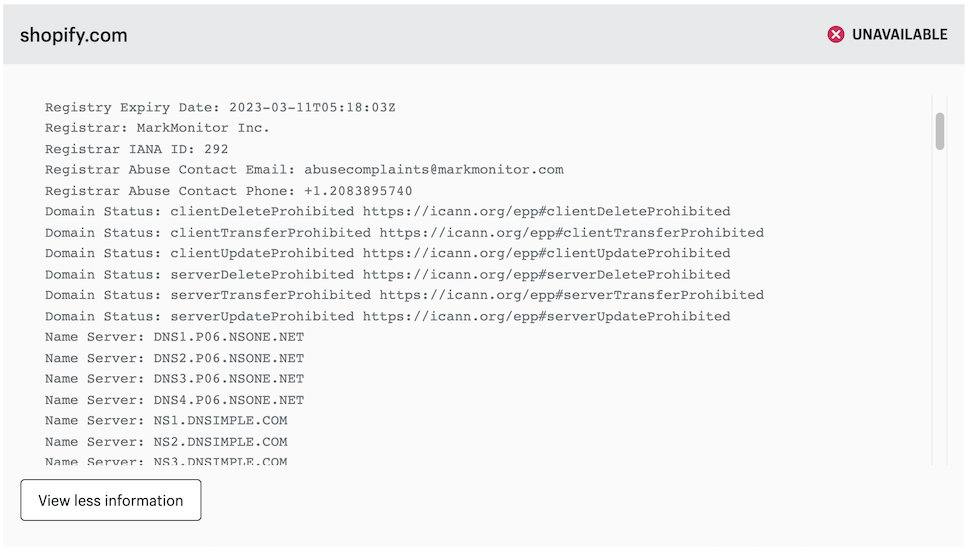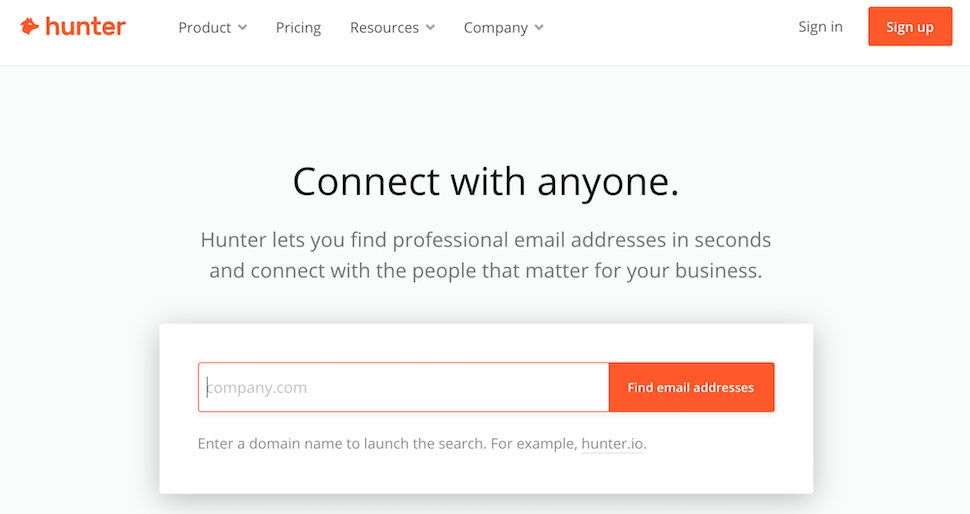How To Find Out Who Owns a Domain Name via WHOIS
There’s a lot of pressure when it comes to naming your online store. Although the process of choosing a name for your business can be fun and spark creativity, it can also feel daunting and arduous—especially if all your ideas seem to be taken. You might find the business name you want is available but someone else has already claimed the corresponding domain name.
But that doesn’t mean you have to go back to the drawing board. In some cases, you can find out who owns the domain (also referred to as the domain registrant) and contact them to negotiate a deal to purchase it. It’s easy to find out that information by using the free domain lookup tool WHOIS (pronounced “who is,” as in: “who is responsible for this domain name”).
Read on for step-by-step instructions on querying WHOIS and getting set up with your new domain.
How to find out who owns a domain
- Navigate to the WHOIS database
- Search for the domain name URL
- Detect if the contact information is private
- Find registrant contact information
1. Navigate to the WHOIS database
Find out who owns a domain by going to the Shopify WHOIS database. In that database, you’ll find key information such as a domain’s registrant name, IP address, and potentially their contact information.
Note: Many domains have this information public in the database, but some domains may employ a privacy shield to hide such information from the general public.

2. Search for the domain name URL
To search for a domain’s information, simply enter the domain URL into the WHOIS database search bar and hit the Search button.
First, WHOIS will show basic information, like the domain name, ID, domain registrar server and URL, and creation date. For example, you can see below that shopify.com was created on March 11, 2003, and is currently registered with MarkMonitor.

From that search result, you can also select View more information to expand the window and see more data about the domain name.

3. Detect if the contact information is private
Sometimes, instead of directly sharing a domain registrant’s contact information in search results, the WHOIS database acts as a go-between between you and the domain registrant. This protects the domain owner’s identity, while still giving you enough information to find a way to contact the domain owner.
When contact info is private, don’t lose hope—it just means you’ll need to do some extra sleuthing to find out who really owns the domain and how to contact them.
4. Find registrant contact information
If the domain owner’s identity is hidden, do a web search to find information about the company that owns the domain. You might find a Contact Us or About Us page that talks about the company’s leadership, founders, owners, and so on.
If that information isn’t available, you may be able to learn where the company is registered and seek out relevant databases that list information about registered companies. Look for the secretary of state or department of revenue websites for the corresponding location. For example, if a domain is owned by a a Florida-registered business, you can use local databases look up business ownership by company name, employer identification number, address, or even registered agent name.
What to do when you find out who owns a domain (in 4 steps)
Once you know who owns a domain you want to acquire, it’s time to to find out how to reach that registrant and attempt to negotiate a deal to transfer domain ownership.
1. Contact the domain owner
First things first—you need to reach out to the domain owner. You might find their contact information using the steps listed above, often in the form of a physical mailing address. But if you want to reach out in a different way, there are some steps you can take to find the appropriate contact.
The best place to start is with a Google search. Simply enter the person’s name on Google to see what comes up. You might also search “[name] email address” or “[name] contact information.” If that doesn’t yield any results, check out databases like Hunter or Linkedin.

2. Negotiate a deal to acquire the domain
If you’re able to get in touch with the domain owner, be prepared to negotiate a deal for the domain. Have a number in mind, but expect to hear a counter offer.
When preparing your quote, consider the domain authority, or how much search equity the existing site has. If it’s clearly out of date and doesn’t show up high in search engine result pages (SERP), you can quote a lower number. But for updated sites with a robust digital presence across multiple channels, you’ll likely want to begin with a higher offer and negotiate from there.
3. Migrate your site to the new domain
If you secure ownership of the domain, you’ll want to migrate your existing site to that domain name. (If you’re starting a website from scratch, skip this step and simply begin to build your website.)
If you build your website on a platform like Shopify, you can migrate to or from pretty much any online site builder. There are several options for migrating a site to Shopify, and each one is a relatively simple process.

4. Come up with new ideas for your domain name
If you weren’t able to secure ownership of this domain name, it’s time to reach out to a different domain registrant or brainstorm some new ideas.
Try these tips to help you choose a domain name without needing to start from scratch:
- Opt for a different top-level domain (TLD). A TLD is the series of letters that follows the dot in a web address. For example, many websites use a .com TLD, but you can also see if your domain name is available at a .co, .org, .shop, .biz, or other TLD, depending on your type of business.
- Add a word to your domain name. Words like “shop” and “buy” make excellent additions to your domain name. For example, if shoes.com isn’t available, you could try shopshoes.com or buyshoes.com.
- Get help from a domain name generator. Make the most of Shopify’s free domain name generator. Plug in your ideas and keywords, and Shopify will suggest creative alternative domain names to use for your business.
Set up your domain with Shopify
Ready to get started with your new website domain? When you register your domain with Shopify, you get automatic access to Shopify’s full suite of business tools to help you manage your domain and beyond. Shopify makes it easier to build a successful business online with tools that streamline inventory management, shipping and fulfillment, marketing automations, and more.




Post Comment